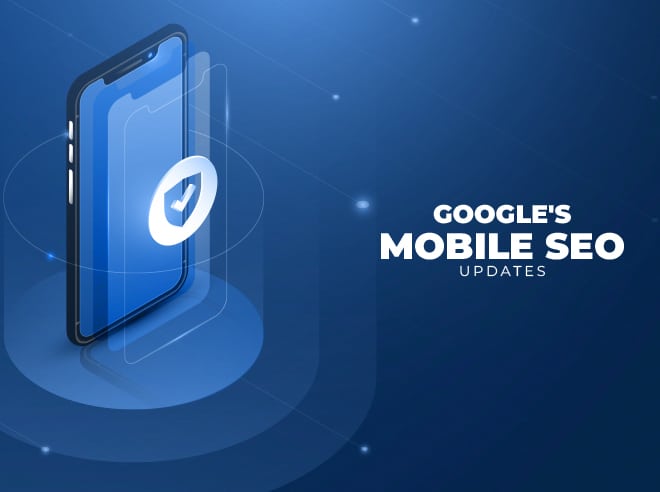Every day we see a new innovative mobile device launched in the market. Today we have all types of mobile devices, from smartphones to wearable devices like smartwatches. Mobile devices have become so popular that most people use desktops for work and watching Netflix.
This shift also means that users use mobile devices for their eCommerce needs. Here we look at why your eCommerce site needs a mobile-first SEO strategy to survive and thrive in 2023. Besides that, we also discuss tips for optimizing your eCommerce store with a mobile-first approach and the benefits of doing the same.
- Website Configuration for Mobile Users
- Page Speed Optimization for Mobile Devices
- Get a Comprehensive Understanding of Google's Mobile-first Index
- Prioritize Mobile Usability
- Keep Following SEO Best Practices
- Efficiently use Structured Data Markup
- Equip Your eCommerce Store for Voice Search
- Content Optimization for Mobile Users
- Prepare an Effective Link-Building Strategy
- Utilize Touchable Elements Smartly
- The Changing Needs of Users and Search Engines
- Appeal to a Wider Audience by Satisfying User Intent
- Get Additional Layers of User Intent via Mobile-first SEO
- Define the Relevance of Your Content for Mobile-first Indexing
- Enhance User-Friendliness
- Ensure Better User Understandability
- Keep Up With Google's Consistent Algorithm Intent
- Get Higher SERP Ranking for Your eCommerce Store
- Ensure Better Communication With Customers and Form Stronger Bonds
- Leverage Customer Data to Your Advantage
- More People Access the Web via Mobiles Than Desktop
- Ensure a Customer-first Approach for Your eCommerce Business
- Build a Visually Pleasing eCommerce Store
- Boost Your SEO Ranking
- Highlight Your Content With a Mobile-first Design
- Get the Upper Hand Over Your Competition
- Boost Your Overall eCommerce Revenue
- Reduced Bounce Rate
- Faster Page Load Speed
- Boost Your Store's Conversion Rate
eCommerce Mobile SEO
Online store owners use eCommerce mobile SEO to boost the ranking of their mobile websites on search engines, including Google. Mobile SEO for eCommerce involves using best practices and tactics in Search Engine Optimization to boost mobile website traffic and visibility.
According to Statista, 59.16% of global website traffic in the last quarter of 2022 was via mobile devices. It means more than half the people browsing online using mobile devices. However, companies can still not ignore traditional SEO. Rainmaker.UNO is an SEO expert specializing in the changing trends in SEO.

Google's Mobile-first Index
One of the most compelling reasons online businesses want to prioritize mobile SEO strategies is Google’s Mobile-first index. Google uses the Mobile-first Index for ranking websites based on how well they can perform on mobile devices. Initially, Google used the desktop version of websites to determine their relevance and assign ranking for specific search queries.
But with more than half the global audience accessing the web through mobile devices, Google quickly had to adopt the mobile-first approach. Your website can still run without a mobile-first SEO strategy, but it will only appear on the Google results page if the target audience is accessing the web through a mobile device. Google’s Mobile-first Index makes sure of it.

Tips to Optimize Your eCommerce Website With Mobile-first SEO Strategy
Optimizing your eCommerce website with an advanced mobile-first SEO strategy is easy with the help of Rainmaker. UNO’s SEO experts. Our experts can optimize every aspect of your mobile-first SEO and prepare your eCommerce store for better traffic and sales.
But don’t worry if you want to avoid hiring an expert team to handle your mobile-first SEO optimization. Ten tips will help you prepare your eCommerce store for advanced mobile-first SEO strategies.
1. Website Configuration for Mobile Users
Pro Tip: Google suggests using responsive designs to ensure effective website configuration for mobile users.
2. Page Speed Optimization for Mobile Devices
Another effective way to enable your eCommerce website to implement advanced mobile-first SEO strategies is page speed optimization. Everyone knows that Google uses website load speed as a primary metric for ranking websites. Page speed is even more vital for mobile websites because the user is easily distracted by push notifications and barely has the patience to let the site load.
Besides minimizing bounce rates, mobile page speed optimization can also help you boost conversions and sales. Some Google-approved tips to ensure a faster page load speed for your mobile website include the following.
- Circumvent redirects on landing pages
- Leverage compression and browser caching
- Image optimization
- Optimize server response time and CSS delivery
- Visible content prioritization

3. Get a Comprehensive Understanding of Google's Mobile-first Index
Preparing your eCommerce store for advanced mobile-first SEO strategies is only possible by understanding Google’s Mobile-first Index. After all, Google processes over 99000 search queries every passing second. Hence, it is unavoidable for eCommerce businesses to understand Google’s Mobile-first Index and optimize their website accordingly.
According to mobile-first indexing, Google uses the performance of the mobile version of websites as the baseline. One of the best practices to ensure quality mobile-first indexing of your site is to use equivalent texts and media for both website versions. Besides that, you can also utilize structured data, title tags, meta descriptions, etc., to optimize your online store mobile-first index.
4. Prioritize Mobile Usability
Merely scaling your eCommerce website does not qualify as efficient mobile usability, as more is needed to rank your website. You must understand how various users navigate your website and enhance the user experience. It involves everything from ensuring fast loading of your website. Hence, you must optimize the overall user experience to improve mobile usability.
We recommend that you suggest that you start by ensuring intuitive navigation in your eCommerce store. Pay special attention to the readability of your website pages and ensure sufficient clickable elements are on every page. You must also pay attention to your contact forms and how you use them across your eCommerce website.
5. Keep Following SEO Best Practices
Following a mobile-first approach for SEO does not mean you can ignore standard SEO best practices. People may be using mobile devices significantly more, but the traditional SEO best strategies apply in most cases.
Keyword research and optimization, meta tag optimization, quality content generation, etc., are still essential SEO practices you need. It is vital to have the expertise to navigate the changing SEO trends, including mobile-first SEO.
Fortunately, our experts can save you a lot of time and effort by creating a custom SEO strategy for your business. Moreover, our experts implement unique techniques, including mobile-first SEO, to maximize the traffic to your eCommerce store.
6. Efficiently use Structured Data Markup
Google utilizes structured data to understand your website content better and collect relevant information. You can use different types of markup depending on your website and its unique requirements. Some popular markup types include reviews, events, products, articles, etc.
It is also worth noting that structured data can help you improve your eCommerce website’s SERP position and enhance its click-through rate. We also advise using Google’s Structured Data Testing Tool to get the best results out of the markups.

7. Equip Your eCommerce Store for Voice Search
More and more users demand voice search capabilities from all their digital interactions, including eCommerce purchases. The immense popularity of voice assistants, such as Google Now, Alexa, and Siri, indicates the growing need for voice assistants in eCommerce. Moreover, voice assistants make life easier for every user, from Baby Boomers to Gen Z.
In other words, the voice assistant is one of the rare technologies that helps everyone. The best thing about voice assistance is that it is so easy to use. Users can speak out about what they want and get relevant results. Several big brands have already enabled voice commerce in their online store. It is only a matter of time before this trend becomes mainstream.
8. Content Optimization for Mobile Users
Content optimization is an integral part of any SEO strategy, mobile-first SEO. If anything, content optimization is even more crucial for mobile devices. A big block of text on a small screen is unlikely to help the user experience, and the chances of the user navigating away are high. The result could be even worse if the content is scattered or improperly displayed on mobile devices.
The goal of the content on your website is to keep them engaged and push them a step closer to the conversion funnel. A virtually endless article is more likely to discourage users from interacting with your content. Hence, your content optimization process should include ensuring shorter paragraphs, appropriate use of headings and sub-headings, etc., to enhance readability.
9. Prepare an Effective Link-Building Strategy
One of the things Google considers when ranking your mobile and desktop website is the internal and external links you use. It is vital to have an effective link-building strategy to ensure your mobile website appears on top of online search results. Link-building for mobile and desktop websites remains the same for the most part.
However, there is one thing you must always be careful about when using internal or external links to your mobile website. You must ensure that all the links you use in your mobile website also lead to mobile sites. Using desktop links in your mobile website could take the user to a poorly readable website, significantly impacting the user experience.

10. Utilize Touchable Elements Smart
One of the vital aspects of mobile-first SEO is the effective utilization of touchable elements in your mobile website. Implementing essential link-building for your website and clustering your website with numerous links are quite different. One of the most nerve-wracking things a user can experience is clicking on something, and an unrelated popup appears.
Since the mobile screen is significantly smaller, you must pay extra attention to the touchable elements. You can avoid clusters of links in your mobile website by replacing regular links with oversized buttons and maintaining the appropriate gaps between touchable elements. Besides that, you can also replace link navigation with mobile-optimized menus.
Reasons to Adopt Mobile-first SEO Strategy for Your eCommerce Website
1. The Changing Needs of Users and Search Engines
2. Appeal to a Wider Audience by Satisfying User Intent
3. Get Additional Layers of User Intent via Mobile-first SEO
4. Define the Relevance of Your Content for Mobile-first Indexing

5. Enhance User-friendliness
6. Ensure Better User Understandability
7. Keep Up With Google's Consistent Algorithm Intent
8. Get Higher SERP Ranking for Your eCommerce Store
9. Ensure Better Communication With Customers and Form Stronger Bonds

10. Leverage Customer Data to Your Advantage
Benefits of Mobile-first SEO Strategy for eCommerce Websites
1. More People Access the Web via Mobiles Than Desktop
There are 5.03 billion Internet users worldwide, and 92.1% of them access the web via mobile phones. It means many people use mobile devices instead of desktops to access the web, including online stores.
eCommerce is all about convenience, and a mobile device is the most convenient way to purchase items online. Mobile devices allow customers to browse for products regardless of the time or place because they always carry their mobile devices with them.
2. Ensure a Customer-first Approach for Your eCommerce Business

3. Build a Visually Pleasing eCommerce Store
4. Boost Your SEO Ranking
5. Highlight Your Content With a Mobile-first Design
6. Get the Upper Hand Over Your Competition
7. Boost Your Overall eCommerce Revenue
8. Reduced Bounce Rate

9. Faster Page Load Speed
10. Boost Your Store's Conversion Rate
How is eCommerce Mobile SEO Different?

Google's Mobile SEO Updates

Final Note
With more and more people opting to use mobile devices to access the web, including eCommerce, mobile-optimizing your online store is more important than ever. The experts at Rainmaker.UNO understands the significance of mobile-first SEO strategy more than anyone else.
We use advanced AI-assisted technologies to optimize eCommerce stores for better inbound traffic and conversions. More importantly, we ensure that your target audience can always access your online store regardless of location or device.
